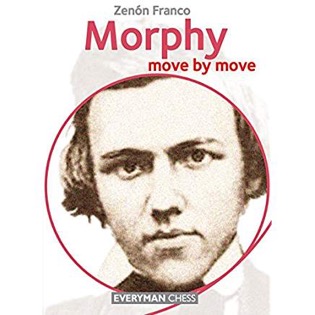Morphy Move by Move
Zenon Franco

The English publishing firm Everyman Chess publishes books for all levels of players from those starting out (Tips for Young Players by Matthew Sadler) to advanced (anything by Garry Kasparov), but it’s bread and butter is the club player market defined roughly as those rated 1700 to 2300. This is a wide range, but most Everyman Chess books fall in this category. That is the case with three recent offerings.
Morphy Move by Move is the fourth book on great players by Paraguayan Grandmaster Zenon Franco, following earlier works on Viswanathan Anand, Boris Spassky and Akiba Rubinstein, and it should receive a warm welcome, particularly from players rated below 2200 who will find much instructive material.
Paul Morphy played over 150 years ago, but his games remain models of how to exploit a lead in development. Because he was so much better than most of the players of his era his games have a crime and punishment quality to them that makes them particularly effective teaching tools. Add to this the Everyman Chess Move by Move format, where the reader is asked a question after practically every move, and you have an excellent and enjoyable way to learn basic principles of the opening and middlegame. Readers rated below 2000 who carefully study the 34 heavily annotated games can’t help but improve.
Cyrus Lakdawalas latest book for Everyman also uses the Move by Move format, engaging the reader with a question and answer format that should make the Sveshnikov (1.e4 c5 2.Nf3 Nc6 3.d4 cxd4 4.Nxd4 Nf6 5.Nc3 e5 6.Ndb5 d6 7.Bg5 a6 8.Na3 b5) accessible to a much wider audience that previous works on the subject. The San Diego International Master devotes 325 pages to the ins and outs of this popular defense, using 41 model games to state his case for Blacks chances, but that is not the only variation he covers. Breaking new ground he spends the last 75 pages of this tome to cover the “Ulfie”.
Never heard of it? Thats because Lakdawala is the first writer to cover this online specialty of the legendary Swedish Grandmaster Ulf Anderson. After 1.e4 c5 2.Nf3 Nc6 3.d4 cxd4 4.Nxd4 Nf6 5.Nc3 e5 6.Ndb5 doesn’t play 6…d6 but instead 6…h6!? to control the d5 square by denying Bg5. After 7.Nd6+ Bxd6 8.Qxd6 Qe7 9.Qxe7+ Kxe7 play transposes into a queenless middlegame where White has the bishop pair but Black also has trumps. His king is well placed for the endgame and his light-squared bishop complements the …e5, …d6 pawn structure. Lakdawala, who has successfully played this line for over a decade, has done much original analysis and practical testing of this variation which requires Black to rely as much on his intuition as concrete calculation. In particular he shows that 7.Be3 is not the refutation of Black’s play as is sometimes claimed. That after 7…d6 8.Nd5 Nxd5 9.exd5 Ne7! 10.c3! Nf5! 11.Bxa7 Be7 Black has good long-term compensation for the pawn.
The Sicilian Sveshnikov Move by Move has a lot going for it. Those who want not just analysis but also prose to explain the ideas behind this aggressive line of the Sicilian will find Lakdawala’s work quite helpful and this includes those rated up to 2300. The second half of the book on the “Ulfie” may prove interesting for even stronger players looking for something a little different – a Sicilian variation where positional understanding often trumps calculating ability. The two lines also pair off well together – one sharp and one considerably quieter – making them the basis for a Black repertoire.
Your Opponent is Overrated by FIDE Master James Schuyler is an interesting and original book that could have also been titled Chess Favors the Optimistic or Play for the Win. Schuyler, who was once one of the top-rated junior players in the United States, focuses on the practical in this volume which covers a potpourri of subjects aimed at getting better results for those in the club player range (1400-2000).
This book features 52 well-annotated games, including a win by Schuyler against former PayPal mogul Peter Thiel who in the late 1980s and early 1990s was rated over 2300 USCF.
Grandmaster Alex Sherzer, who grew up near Schuyler, has five wins of his wins featured. This reviewer agrees with the author that Sherzer worked hard on his chess and recalls him systematically going through Averbakh’s Comprehensive Endgame series (easily over 1000 pages!), something that paid big dividends for his understanding of the game. However Sherzers assertion that he was not particularly talented could certainly be debated. After all he taught himself Hungarian (motivated by his friendship with Sofia Polgar when they were young) and later became a medical doctor. The ability to work hard is a talent in its own right.
All three of these books should prove helpful for the aspiring club player aiming to become a master.
Everyman books are available not only as printed books, but also in electronic form which includes four formats – ChessBase (CBV), PGN, Kindle and E-books for one price.
